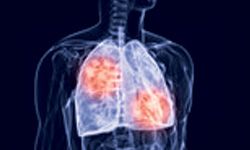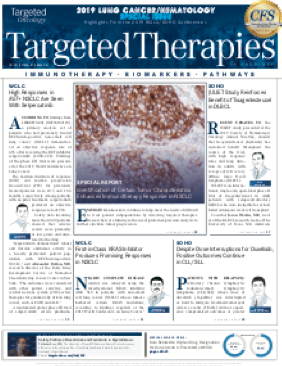Expert Reports Mixed Results in Interim Analysis for Multiarm NSCLC Trial
Findings from an interim analysis of the National Lung Matrix Trial, a large, multiarm trial involving patients with non–small cell lung cancer, demonstrated both promising activity and shortcomings in predefined goals in a presentation at the 2019 World Conference on Lung Cancer.

Findings from an interim analysis of the National Lung Matrix Trial (NLMT; NCT02664935), a large, multiarm trial involving patients with nonsmall cell lung cancer (NSCLC), demonstrated both promising activity and shortcomings in predefined goals in a presentation at the 2019 World Conference on Lung Cancer. Cancer investigator Gary Middleton, MBBS, MD, a professor of medical oncology at the University of Birmingham in the United Kingdom, presented the findings, which involved 19 of 22 mutation-defined patient cohorts and 8 targeted therapies, several of which had promising activity.
For example, the tyrosine kinase inhibitor crizotinib (Xalkori) had a >99% probability of achieving a defined rate of durable clinical benefit (DCB) and objective response (OR) rate for patients withROS1fusions andMETexon 14 skipping. However, positive findings were not always identified, because many of the matchups in the NLMT appeared unlikely to reach predefined goals for DCB, OR, or progression-free survival (PFS).
Middleton suggested several explanations for the results and strategies to turn apparently poor targets into potentially good targets: “One of the risks with the paradigm of precision medicine is that we focus on very high levels of single-agent activity in oncogene addiction,” he said. “We might be missing a trait, or we might be missing a useful target in our patients.”
As an example, he cited palbociclib (Ibrance) and capivasertib, both chosen for NLMT, for estrogen receptorpositive breast cancer. As single agents, the drugs had very modest activity, but studies subsequently showed that the drugs became much more effective in combination with fulvestrant. “Critically, there is no evidence at all that the putative biomarkers for palbociclib or capivasertib are actually useful,” he said.
Tobacco-associated lung cancer poses a multiplicity of obstacles for therapeutic development: genetic instability, ongoing evolution, onco-gene predominancy, and numerous pathways to resistance.
“That brings up the criticality of the preclinical models that we need,” Middleton said. “We need to make sure that the targets we are gunning for are tested in models that completely replicate the genomic complexity and chaos of tobacco-associated nonsmall cell lung cancer.”
The observations and comments followed his presentation of initial findings from the ongoing NLMT. The trial currently has 22 mutation-defined cohorts within 4 pathways of genomic alteration treated with 1 of 7 targeted drugs: cell cycle progression (palbociclib), RAS activation (palbociclib, vistusertib, and selumetinib/ docetaxel), PI3K/PTEN/AKT/mTOR (vistusertib, capivasertib), and RTK signaling (FGFR inhibitor AZD4547, crizotinib, osimertinib [Tagrisso]).
Each cohort eventually will have 30 patients. The Bayesian adaptive design of the trial allows for interim analyses to predict outcomes when a cohort is fully accrued.
The principal outcomes of interest are OR and DCB (stable disease or better for ≥24 weeks), except for the RAS activation category, which has endpoints of DCB and median PFS. The target estimates for OR and DCB are >30% for single-agent treatment and >40% for a combination, and the median PFS target is 3 months.
Investigators used Bayesian methodology to estimate true rates and medians and credible 95% confidence intervals. A treatment is considered a go for further evaluation if the posterior probability of exceeding a target estimate is >0.50.
For the cell cycle progression category, median PFS with palbociclib exceeded the 3-month target for tumors withCDKN2Aloss (2 sub-groups) andCCND1amplification. Predictive probability of success (PPoS) ranged from 0.69 to 0.98. Median PFS remained below the target for tumors withCDK4amplification, which was associated with a PPoS of 0.23. The DCB target had yet to be reached for any of the 4 subgroups.
In the RAS activation category, the combination of selumetinib and docetaxel had a 50% DCB and PPoS of 0.89 for the subgroup withNF1mutation, as well as a median PFS of 5.6 months. Palbociclib for tumors withKRASmutation resulted in a median PFS of 5.4 months and a predicted probability >0.99, and it also had a DCB rate of 44%. Three other subgroups appeared unlikely to meet DCB or PFS targets.
In the PI3K/PTEN/AKT/mTOR category, the DCB rates for the 5 subgroups ranged from 9% to 21%, associated with PPoS of 0.06 to 0.34. The PPoS for the response target was <0.20 for all the subgroups.
The RTK signaling group had 4 subgroups with DCB rates that exceeded the targets, and 3 of the 4 exceeded response targets. Crizotinib for tumors withROS1gene fusions andMETexon 14 skipping alterations had DCB rates of 71% and 80%, respectively, and OR rates of 68%, both associated with PPoS >0.99. Osimertinib forEGFRT790M mutation had a 94% DCB and an OR rate of 76%, with a PPoS >0.99. AZD4547 forFGFRmutation had passed the DCB target (31%), which was associated with a PPoS of 0.54. Crizotinib for tumors withMETamplification appeared unlikely to meet the DCB or response target.
In closing, Middleton showed the impact of smoking status and histology on the interim results. Light smokers (≤10 pack years) and never smokers had response rates of 17% and 28%, respectively, compared with patients who had smoking histories of 10 to 30 pack years (7%) and >30 pack years (10%). Similarly, responses occurred substantially more often among non-squamous versus squamous tumors (16% vs 1%). He noted that 99% of the patients with squamous cell histology had been treated with palbociclib or capivasertib.
Reference:
Middleton G, Popat S, Fletcher P, et al. National Lung Matrix Trial (NLMT): first results from an umbrella phase II trial in advanced non-small cell lung cancer (NSCLC). Presented at: International Association for the Study of Lung Cancer 20th World Conference on Lung Cancer; September 7-10, 2019; Barcelona, Spain. Abstract PL02.09.
